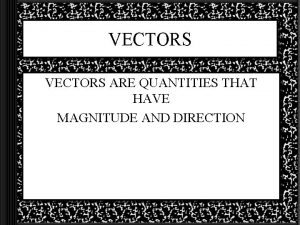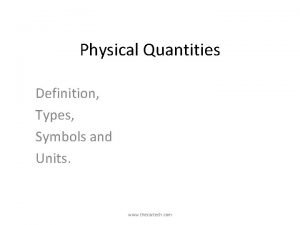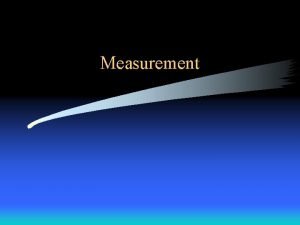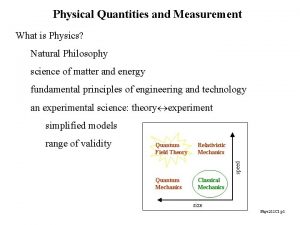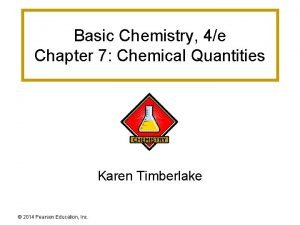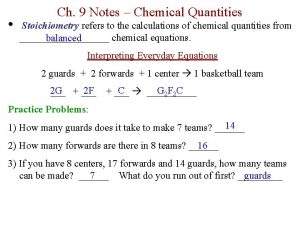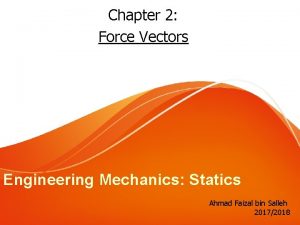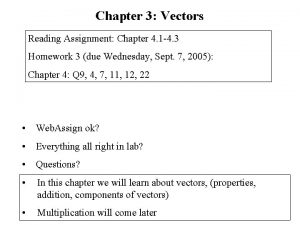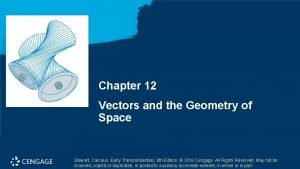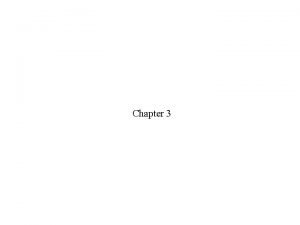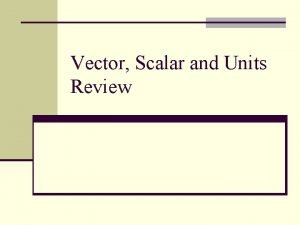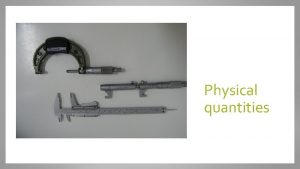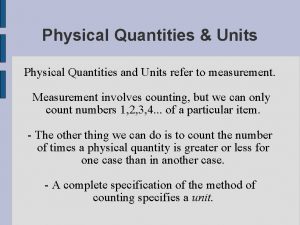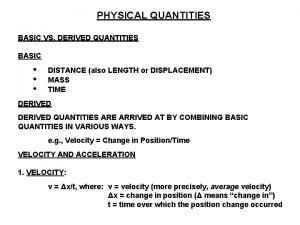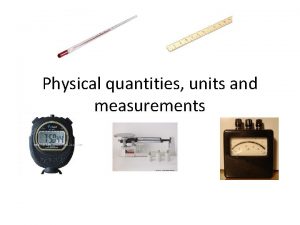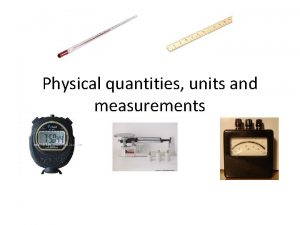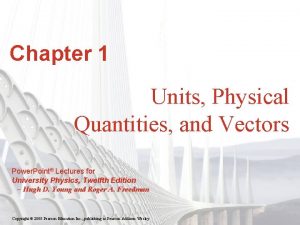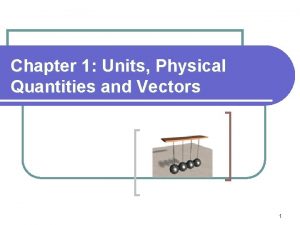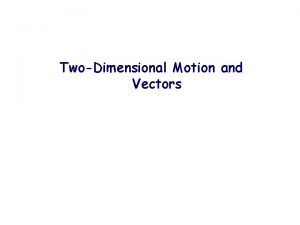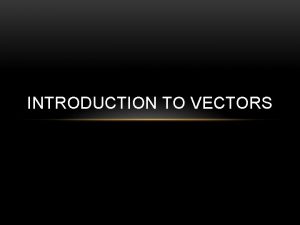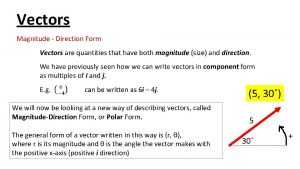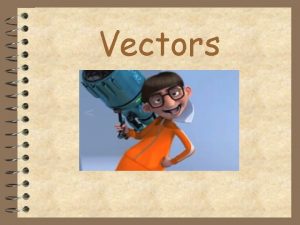Chapter 3 Vectors Vectors Vectors physical quantities having





















- Slides: 21

Chapter 3 Vectors

Vectors • Vectors – physical quantities having both magnitude and direction • Vectors are labeled either a or • Vector magnitude is labeled either |a| or a • Two (or more) vectors having the same magnitude and direction are identical

Vector sum (resultant vector) • Not the same as algebraic sum • Triangle method of finding the resultant: a) Draw the vectors “head-to-tail” b) The resultant is drawn from the tail of A to the head of B R=A+B B A

Addition of more than two vectors • When you have many vectors, just keep repeating the process until all are included • The resultant is still drawn from the tail of the first vector to the head of the last vector

Commutative law of vector addition A+B=B+A

Associative law of vector addition (A + B) + C = A + (B + C)

Negative vectors Vector (- b) has the same magnitude as b but opposite direction

Vector subtraction Special case of vector addition: A - B = A + (- B)

Multiplying a vector by a scalar • The result of the multiplication is a vector c. A=B • Vector magnitude of the product is multiplied by the scalar |c| |A| = |B| • If the scalar is positive (negative), the direction of the result is the same as (opposite to that) of the original vector

Vector components • Component of a vector is the projection of the vector on an axis • To find the projection – drop perpendicular lines to the axis from both ends of the vector – resolving the vector

Vector components

Unit vectors • Unit vector: A) Has a magnitude of 1 (unity) B) Lacks both dimension and unit C) Specifies a direction • Unit vectors in a right-handed coordinate system

Adding vectors by components In 2 D case:

Chapter 3 Problem 33 Vector B has z, y, and z components of 4. 00, 6. 00, and 3. 00 units, respectively. Calculate the magnitude of B and the angles B makes with the coordinate axes.

Answers to the even-numbered problems Chapter 3 Problem 4: y = 1. 15; r = 2. 31

Answers to the even-numbered problems Chapter 3 Problem 6: 310 km at 57° S of W

Answers to the even-numbered problems Chapter 3 Problem 16: 1. 31 km north; 2. 81 km east

Answers to the even-numbered problems Chapter 3 Problem 20: - 25. 0 m i^ + 43. 3 m j^

Answers to the even-numbered problems Chapter 3 Problem 24: (b) 5. 00 i^ + 4. 00 j^, 6. 40 at 38. 7°; – 1. 00 i^ + 8. 00 j^, 8. 06 at 97. 2°

Answers to the even-numbered problems Chapter 3 Problem 30: C = 7. 30 cm i^ - 7. 20 cm j^

Answers to the even-numbered problems Chapter 3 Problem 52: (a) 2. 00, 1. 00, 3. 00 (b) 3. 74 (c) θx = 57. 7°, θy = 74. 5°, θz = 36. 7°
 Units physical quantities and vectors
Units physical quantities and vectors Slidetodoc.com
Slidetodoc.com Magnitude of unit vector formula
Magnitude of unit vector formula Angular vs linear velocity
Angular vs linear velocity Magnitude of a vecotr
Magnitude of a vecotr W=mg units
W=mg units Measurable characteristics that describe an object
Measurable characteristics that describe an object Physical quantities and measurement class 6 worksheet
Physical quantities and measurement class 6 worksheet Label an atom
Label an atom Chemistry chapter 10 chemical quantities
Chemistry chapter 10 chemical quantities Chapter 7 chemical quantities answer key
Chapter 7 chemical quantities answer key Chapter 10 chemical quantities
Chapter 10 chemical quantities Chapter 10 chemical quantities practice problems answer key
Chapter 10 chemical quantities practice problems answer key Chapter 9 chemical quantities
Chapter 9 chemical quantities Physical rate fences example
Physical rate fences example Physical fitness grade 9
Physical fitness grade 9 Chapter 2 force vectors
Chapter 2 force vectors Chapter 3 vectors worksheets
Chapter 3 vectors worksheets A 100 lb weight hangs from two wires
A 100 lb weight hangs from two wires Chapter 12 vectors and the geometry of space solutions
Chapter 12 vectors and the geometry of space solutions This chapter shows how vectors can be added using
This chapter shows how vectors can be added using Scalar vs vector
Scalar vs vector




